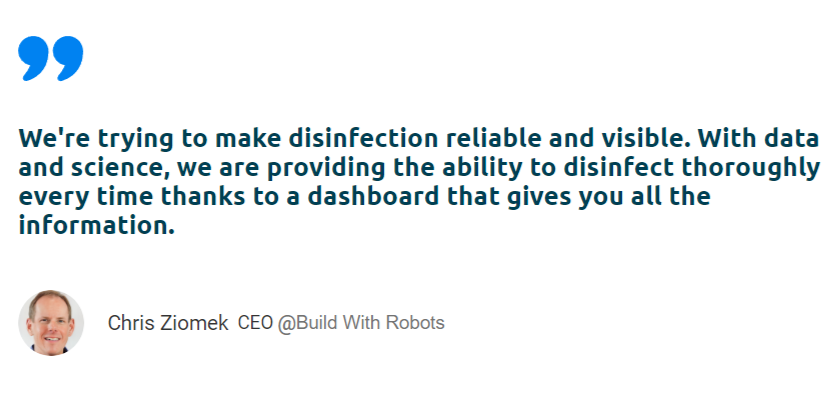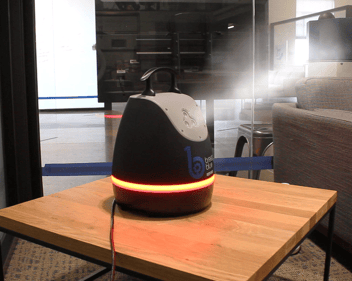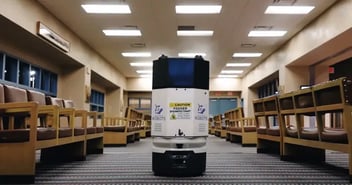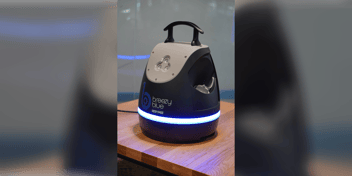
A Cleaner World: The Benefits of Autonomous Disinfection Robots
Chris Ziomek, Founder & CEO at Build With Robots, joins Builder Nation's Podcast host Elisa Muñoz to share his experiences as a leader in Robotics and the insights he has gained from 30 years of being an entrepreneur in high-tech.
This interview was brought to you by BuilderNation, the community of Hardware leaders developing world-changing products, and sponsored by ControlHub, the purchasing software for hardware companies.
The COVID-19 pandemic changed how we view cleanliness and hygiene in public spaces. With the rise of infectious diseases, it has become increasingly important to maintain a clean and healthy environment in all public spaces, including schools, airports, stadiums, and other high-traffic areas.
Fortunately, there is a new technological solution that has emerged in recent years to help combat the spread of disease in public spaces: autonomous disinfection robots. These robots are capable of cleaning and disinfecting public areas without human intervention, making them an ideal solution for high-traffic areas where cleanliness and hygiene are essential.
This blog post will provide an overview of autonomous disinfection robots, their benefits, and the various use cases in which they are used. We will also answer frequently asked questions about this technology and discuss its future potential for further development.
How Do Autonomous Disinfection Robots Work?
Autonomous disinfection robots use various technologies to navigate through public spaces and disinfect them. These robots are equipped with sensors and mapping systems to detect obstacles and map out the area they need to clean.
They use a variety of disinfection methods, including ultraviolet (UV) light, electrostatic sprayers, and dry foggers, to disinfect surfaces and the air in the area.
UV disinfection robots use UV-C light to kill bacteria and viruses on surfaces. The robots emit a high-intensity UV-C light that damages the DNA of microorganisms, rendering them unable to reproduce or cause infections. These robots effectively disinfect line-of-sight surfaces, but they have limited coverage and require dwell time to be effective.
Electrostatic sprayers use a liquid disinfectant that is charged with an electrostatic charge. This creates a fine mist that clings to surfaces and effectively disinfects them. These sprayers effectively disinfect surfaces, fabrics, and hard-to-reach areas, but they also require dwell time to be effective.
Dry foggers, like the Breezy Blue Fogger, use fogging technology to generate a dry fog with particle sizes between 20 and 100 microns. This provides superior coverage for disinfecting surfaces, fabrics, and hard-to-reach areas. Breezy Blue is capable of disinfecting a 1000 square foot room in 45 seconds.
Benefits of Using Autonomous Disinfection Robots
Using autonomous disinfection robots in public spaces offers numerous benefits. Firstly, these robots are effective in reducing the spread of diseases. Their ability to quickly and efficiently disinfect large areas helps to maintain cleanliness and hygiene in public spaces.
Secondly, using these robots can significantly reduce manual cleaning and disinfection costs. By utilizing robots to disinfect public spaces, companies, and organizations can save costs and increase efficiency by reducing the manual labor required for cleaning and disinfecting.
Lastly, autonomous disinfection robots can give people peace of mind when using public spaces. By ensuring that public spaces are thoroughly disinfected, individuals can feel more confident about the cleanliness and safety of these areas.
From Airports to Stadiums: Use Cases for Autonomous Disinfection Robots
Autonomous disinfection robots are increasingly being used in public spaces like airports, buses, and stadiums to minimize the risk of spreading disease. These robots use various disinfection methods, such as UV light, electrostatic sprayers, and fogging, to disinfect high-traffic areas where people are more likely to come into contact with harmful pathogens, reducing the time and cost associated with manual cleaning.
Airports
Airports are a common use case for autonomous disinfection robots, given the millions of travelers who pass through daily. Build with Robots offers innovative solutions to enhance airport operations' efficiency, such as the Breezy Blue Response Disinfecting Minibot and the Breezy One Autonomous Disinfecting Robot, which help ensure every person's safety and increase customer satisfaction.
→ Click here to learn more about Build with Robot’s airport solutions.
Buses
Similarly, hundreds of passengers use buses daily, increasing the risk of spreading disease. Build with Robots offers solutions such as the Breezy Blue Response and Breezy BioCare RTU to disinfect buses and prevent illnesses, ensuring that people can get to their destinations safely.
→ Click here to learn more about Build with Robot’s solutions for buses.
Stadiums
Stadiums and arenas are also common use cases for autonomous disinfection robots since thousands of fans attend games, increasing the risk of spreading disease.
Build with Robots offers innovative solutions such as the Breezy One Autonomous Disinfecting Robot and the Breezy BioCare RTU to enhance facility sanitization, reduce the risk of infection, and provide a safe environment for fans, performers, and staff.
→ Click here to learn more about Build with Robot’s stadiums and arenas solutions.
FAQs
Here are some frequently asked questions about autonomous disinfection robots:
- How fast does Breezy One™ operate?
Breezy One™ is capable of disinfecting up to 100,000 sq. ft. per hour under normal operation.
- How difficult is Breezy to operate?
Breezy One™ and Breezy Blue™ are operated at the push of a button.
- Is Breezy a fogger or a sprayer?
Both Breezy Blue™ and Breezy One™ use fogging technology to generate a dry fog with particle sizes between 20 and 100 microns, providing superior coverage for disinfecting surfaces.
- What pathogens does Breezy kill?
Breezy BioCare™ RTU is a broad-spectrum disinfectant that kills a variety of bacteria, viruses, and mold, including: Staphylococcus Aureus, Pseudomonas Aeruginosa, Salmonella Enterica, E. Coli, Listeria, Trichophyton Mentagrophytes, Coronavirus, Norovirus, Rhinovirus, and H1N1.
Future of Autonomous Disinfection Robots
The use of autonomous disinfection robots has become increasingly popular in recent years, and the technology is expected to continue to develop and improve. As the world becomes more aware of the importance of disinfection in public spaces, the demand for these robots is likely to increase.
In the future, we can expect to see more advanced mapping systems, sensors, and disinfection methods used by autonomous robots. One potential development is using artificial intelligence (AI) to make these robots even more efficient and effective.
With AI, robots could learn from their past disinfection experiences, adapting to better address specific areas that require more attention. This would improve the efficiency and effectiveness of the disinfection process, ensuring that all surfaces are thoroughly cleaned.
Additionally, we can expect to see the integration of disinfection robots with other technology, such as HVAC systems, to ensure that air quality is maintained. With the rise of smart buildings, the potential for integrating these technologies is high, allowing for more comprehensive disinfection practices.




